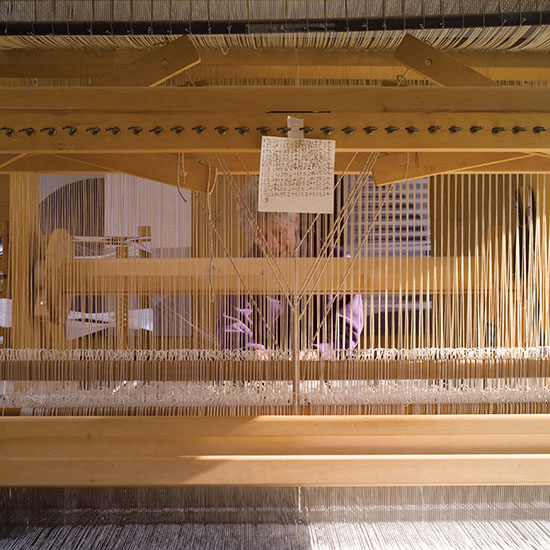This week will mark the opening at the of an extraordinary exhibition at the Art Institute of Chicago of works by Ethel Stein, a master weaver who, at 96, is at last gaining the wider recognition she so decidedly deserves. Stein has never been overly concerned with promoting or marketing her work, though browngrotta arts has been pleased to document and promote her art since 2008. She has been steadfastly “counter-trend,” as textile designer Jack Lenor Larsen has aptly put it, creating squares of quiet pattern to be placed on walls at a time when other textile artists were emphasizing the sculptural potential of fiber by working in three dimensions. Produced on a drawloom—a type of handloom that incorporates a figure harness capable of controlling each warp thread separately—her work seems deceptively simple, but as one understands the mysteries and complexities of this weaving method historically favored for creating figured textiles, the sophistication and challenge of her work become undeniable.
Stein’s work combines traditional weaving techniques, possible only on a drawloom and used by few contemporary weavers, with modernist sensibilities influenced by Josef Albers, who trained in the German Bauhaus with its emphasis on simplicity, order, functionality, and modesty. “As a weaver,” Lucy Commoner, Senior Textile Conservator at the Cooper Hewitt National Design Museum, Smithsonian Institution, has explained, “Stein’s work is informed by her research in museum textile collections, a rich source of design resource material.” In the 1970s, Stein studied and analyzed textiles in the collections of the Metropolitan Museum of Art and the Cooper-Hewitt. At the Cooper-Hewitt, she explored a vast collection, from ancient to contemporary pieces, and, with former Curator of Textiles, Milton Sonday, analyzed through a microscope the woven surfaces of textiles in the collection, which she documented by producing drawings of the structures. “The experience was crucial to Stein’s development as an artist,” writes Commoner, “and stimulated her interest in decoding how these historic textile structures could be produced on a contemporary draw loom. Ethel Stein’s mastery of a variety of historical textile techniques gives her a wide range of artistic expression through the control of color and pattern.” Stein has favored three particular structures with strong historical traditions—damask, double-cloth, and lampas—and it is due to the flexibility of the drawloom that her work appears so meticulously refined yet refreshingly uncomplicated. You can glimpse a bit of her process in this short video by Mark Chamberlin: http://vimeo.com/97457445.
Ethel Stein, Master Weaver, presented in the newly reopened textiles galleries comprised of the Agnes Allerton Gallery and the Elizabeth F. Cheney Gallery, presents drawloom weavings executed by the artist from 1982 through 2008. All works are either already in the collection of the Art Institute or have been promised as gifts. The retrospective installation celebrates in particular Ethel Stein’s generous donation of 34 of her own works two years ago, as well as Leanne Lachman’s promised gift of four additional pieces, which help fill out the picture of Stein’s impressive career. These 38 weavings join a work in five parts, woven in 1982, added to the collection in 1985, courtesy of the Nicole Williams Contemporary Textile Fund.
A catalog prepared by browngrotta arts in 2008, Ethel Stein: Weaver, which includes an introduction by Jack Lenor Larsen and an essay by Lucy Commoner, Senior Textile Conservator at the Cooper Hewitt National Design Museum, Smithsonian Institution, will be available at The Art Institute and on our website: http://browngrotta.com/Pages/m03.php. The exhibition runs from Friday June 13th through Sunday, November 9, 2014. For more information, visit: http://www.artic.edu/exhibition/ethel-stein-master-weaver-0.




